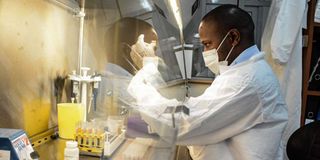Premium
Alarm over test kits shortage as Kenya inches closer to peak

A researcher at Kemri prepares reagents for testing samples for Covid-19.
What you need to know:
- The government has made just about every possible mistake in handling the pandemic.
- It is now doing under 5,000 tests a day, despite spending over Sh1.8 billion on reagents.
- The test is free in State facilities but private labs charge between Sh8,700-Sh10,000.
As Kenya inches closer to the peak of Covid-19 pandemic, a shortage of reagents for testing and contact tracing remain the biggest challenges.
With the country just weeks away from the projected 450,000 positive cases, State labs are running on empty.
The government has made just about every possible mistake in handling the pandemic and is now doing under 5,000 tests a day, despite spending over Sh1.8 billion on reagents. About 400,000 samples have so far been tested with over 30,000 turning up positive.
The Nation has established that the National Influenza Lab and the Kenyatta National Hospital have a backlog of unprocessed samples due to the shortages caused by a worldwide race to acquire testing kits.
“We’ve had a shortage for some time and Kenyatta National Hospital along with other government labs cannot conduct the tests,” said a senior official at the National Influenza Lab.
“The shortage is mostly on the automated kits, like the reagents for Roche.”
Charges
The test is free in State facilities but private labs charge between Sh8,700-Sh10,000.
“We are not flattening the curve. There are challenges with testing and the reagent issues will be sorted out next week. Kemri will then get back to testing more samples,” Health CAS Mercy Mwangangi said Wednesday.
Despite the rising caseload and the reopening of the economy, the government has shut down some quarantine facilities with reports from various counties that isolation centres are not fully operational.
On Tuesday, Health CAS Rashid Aman said with the widespread community transmission, there was “a need to re-evaluate the testing strategy”.
His sentiments came barely a week after the Kenya Medical Research Institute Wellcome Trust in Kilifi stated that 2.7 million Kenyans had “been exposed to the virus”.
“Our strategy remains the same: trace, isolate and treat. It’s not different from other countries,” Dr Mwangangi said.
Last month, Dr Patrick Amoth, the Health Director-General, said it was not possible to test everyone due to the costs involved.
“For instance, out of 100 people in a target mass testing, only 10 can be positive. That means the reagents used in testing the remaining 90 have been wasted. If we concentrate on those with symptoms, the positive cases will be high,” he said.
Afterthought
Mr Ndung’u Wainaina, executive director of the International Center for Policy and Conflict, says the country’s rapidly shifting strategies are a reflection of “afterthought and catching up” rather than a cogent strategy with an epidemiologic basis. “Kenya has had low testing rates. It’s thus crucial to have accelerated capacity enhancement of the counties. The government should also support free testing in private laboratories,” he said.
Going forward, he urged the government to improve its national testing and tracing strategy. “We need random testing, looking at all geographical areas and at different population groups, and not just the so-called high-risk ones,” Mr Wainaina said.
“Random but systematic testing is not mass testing. Right now, the government waits for an outbreak, then rushes in to test. This has high risk of being overwhelmed by the speed of its spread.”
The ministry failed to meet its target of testing 250,000 people by the end of June. Contact tracing, which is crucial in testing, has been poor. “Contact tracing is a resource-intensive programme and with the sustained community transmission, it’s now weaker. There is need to change this strategy,” Dr Mwangangi said.
The strategy was, however, barely working even before the community transmission phase, largely due to human and financial shortcomings and poor technology.
Volunteers not motivated
“Human resource remains a big challenge. We only have four employees, while the remaining 28 are volunteers. Management of volunteers is not an easy task as they’re not always motivated,” Dr Francis Kuria, an incident commander at the contact tracing and data management centre, said.
As of Sunday, only 30 counties had submitted contact tracing reports, while more than 5, 540 cases had not been touched. Samburu, Kirinyaga, Kirinyaga, Muran’ga, Nandi, Lamu and Tana River had not submitted their contact tracing reports.
The ministry has also failed to conduct surveillance for Covid-19 and related Influenza-like illnesses through accredited social health workers and nurses, and severe acute respiratory illness through clinical institutions, including private hospitals, daily data reporting to identify geographic clustering of cases to trace transmission hot spots.
“The use of already existing serological surveillance platform like HIV could be a cost-effective way to do the serological surveillance and provide an estimate of the burden and trend,” Mr Wainaina said.






